Septal leads - Study guides, Class notes & Summaries
Looking for the best study guides, study notes and summaries about Septal leads? On this page you'll find 1208 study documents about Septal leads.
Page 2 out of 1.208 results
Sort by
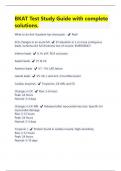
-
BKAT Test Study Guide with complete solutions |Latest 2024/2025
- Exam (elaborations) • 17 pages • 2024
- Available in package deal
-
- $10.49
- + learn more
BKAT Test Study Guide with complete solutions. What to do first if patient has chest pain. ️ Rest! ECG changes in an acute MI ️ ST elevation in 2 or more contiguous leads. Ischemia d/t full thickness loss of muscle. EMERGENCY. Inferior leads ️ II, III, aVF. RCA occlusion. Septal leads ️ V1 & V2. Anterior leads ️ V1 - V4. LAD lesion. Lateral leads ️ V5, V6, I, and aVL. Circumflex lesion. Cardiac enzymes ️ Troponins, CK-MB, and CK Changes in CK ️ Rise: 3-6 hours Peak: 24...
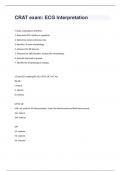
-
CRAT exam: ECG Interpretation verified already passed 2024/2025
- Exam (elaborations) • 76 pages • 2024
- Available in package deal
-
- $22.99
- + learn more
CRAT exam: ECG Interpretation7 steps, analyzing 12 lead ECG 1. Determine ECG rhythm or regularity 2. Determine atrial ventricular rate. 3. Identify a P-wave morphology. 4. Measure the PR interval. 5. Measure the QRS duration, analyze the morphology. 6. Evaluate the leads in groups. 7. Identify the morphological changes. 12 lead ECG reading BIG LIE, LITTLE LIE, SAY, ALL Big LIE I: lateral II: inferior III: inferior LITTLE LIE aVR: not used for MI interpretation. Useful for dex...
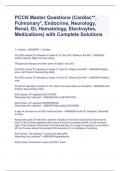
-
PCCN Master Questions (Cardiac**, Pulmonary*, Endocrine, Neurology, Renal, GI, Hematology, Electroytes, Medications) with Complete Solutions
- Exam (elaborations) • 24 pages • 2024
- Available in package deal
-
- $11.99
- + learn more
PCCN Master Questions (Cardiac**, Pulmonary*, Endocrine, Neurology, Renal, GI, Hematology, Electroytes, Medications) with Complete Solutions PCCN Master Questions (Cardiac**, Pulmonary*, Endocrine, Neurology, Renal, GI, Hematology, Electroytes, Medications) with Complete Solutions PCCN Master Questions (Cardiac**, Pulmonary*, Endocrine, Neurology, Renal, GI, Hematology, Electroytes, Medications) with Complete Solutions 1. Cardiac - ANSWER-1. Cardiac Pt's EKG shows ST elevation i...
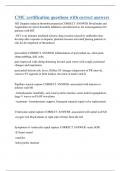
-
CMC certification questions with correct answers
- Exam (elaborations) • 46 pages • 2023
-
- $15.49
- + learn more
HIT (heparin induced thrombocytopenia) CORRECT ANSWER Bivalirudin and Argatroban are direct thrombin inhibitors and alternatives for anticoagulation for patients with HIT. - HIT is an immune mediated adverse drug reaction caused by antibodies that develop after exposure to heparin, platelets become activated placing patients at risk for development of thrombosis pericarditis CORRECT ANSWER inflammation of pericardial sac, chest pain-sharp,stabbing, dull, achy pain improved with sitting &le...
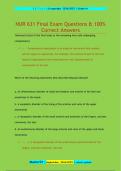
-
NUR 631 Final Exam Questions & 100% Correct Answers
- Exam (elaborations) • 127 pages • 2024
-
- $13.49
- + learn more
Removal of part of the liver leads to the remaining liver cells undergoing compensatory :~~ Compensatory hyperplasia is an adaptive mechanism that enables certain organs to regenerate. For example, the removal of part of the liver leads to hyperplasia of the remaining liver cells (hepatocytes) to compensate for the loss. Which of the following statements best describes Raynaud disease? a. An inflammatory disorder of small and medium-size arteries in the feet and sometimes in the ha...
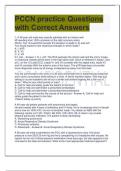
-
PCCN practice Questions with Correct Answers
- Exam (elaborations) • 26 pages • 2024
-
- $13.29
- + learn more
PCCN practice Questions with Correct Answers 1. A 49-year-old male was recently admitted with an inferior wall MI resulting from 100% occlusion of the right coronary artery (RCA). The 12-Lead ECG reveals ST elevation in leads II, Ill, and avF. You would expect to see reciprocal changes in which leads? A. I, aVR B. V, V2 C. V, VA D I, aVL - Answer-1. D. I, aVI. The RCA perfuses the inferior wall and the mirror image or reciprocal change will be seen in the high latera wall, which is refl...
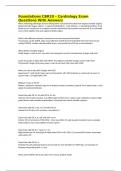
-
Foundations CBR20 – Cardiology Exam Questions With Answers
- Exam (elaborations) • 25 pages • 2024
-
- $10.59
- + learn more
Foundations CBR20 – Cardiology Exam Questions With Answers What underlying pathologic process distinguishes myocardial infarction from angina/unstable angina? Atherosclerotic plaque rupture → exposed endothelium → clot attaches → reduced blood flow; if cell death occurs (usually due to complete vascular obstruction) then positive trop and MI; if no cell death occurs then negative trop and angina/unstable angina What is the difference between transmural and non-transmural infarctio...
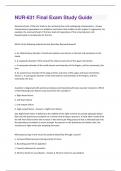
-
NUR-631 Final Exam Study Guide Graded A+
- Exam (elaborations) • 70 pages • 2024
- Available in package deal
-
- $9.49
- + learn more
Removal of part of the liver leads to the remaining liver cells undergoing compensatory - Answer Compensatory hyperplasia is an adaptive mechanism that enables certain organs to regenerate. For example, the removal of part of the liver leads to hyperplasia of the remaining liver cells (hepatocytes) to compensate for the loss. Which of the following statements best describes Raynaud disease? a. An inflammatory disorder of small and medium-size arteries in the feet and sometimes in the hands...
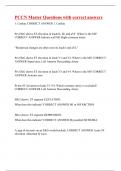
-
PCCN Master Questions with correct answers
- Exam (elaborations) • 40 pages • 2023
- Available in package deal
-
- $14.49
- + learn more
1. Cardiac CORRECT ANSWER 1. Cardiac Pt's EKG shows ST elevation in leads II, III, and aVF. Where is the MI? CORRECT ANSWER Inferior wall MI, Right coronary artery "Reciprocal changes are often seen ini leads I and aVL" Pt's EKG shows ST elevation in leads V1 and V2. Where is the MI? CORRECT ANSWER Septal area, Left Anterior Descending Artery Pt's EKG shows ST elevation in leads V3 and V4. Where is the MI? CORRECT ANSWER Anterior area Pt has ST elevation in leads V1-V4. Which...
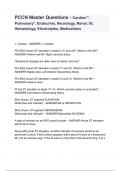
-
PCCN Master Questions - Cardiac**, Pulmonary*, Endocrine, Neurology, Renal, GI, Hematology, Electrolytes, Medications
- Exam (elaborations) • 31 pages • 2024
-
- $7.99
- + learn more
1. Cardiac - ANSWER-1. Cardiac Pt's EKG shows ST elevation in leads II, III, and aVF. Where is the MI? - ANSWER-Inferior wall MI, Right coronary artery "Reciprocal changes are often seen ini leads I and aVL" Pt's EKG shows ST elevation in leads V1 and V2. Where is the MI? - ANSWER-Septal area, Left Anterior Descending Artery Pt's EKG shows ST elevation in leads V3 and V4. Where is the MI? - ANSWER-Anterior area Pt has ST elevation in leads V1-V4. Which coronary artery is occluded? -...

Study stress? For sellers on Stuvia, these are actually golden times. KA-CHING! Earn from your study resources too and start uploading now. Discover all about earning on Stuvia


